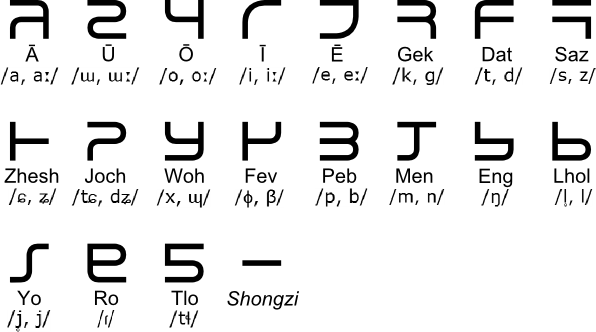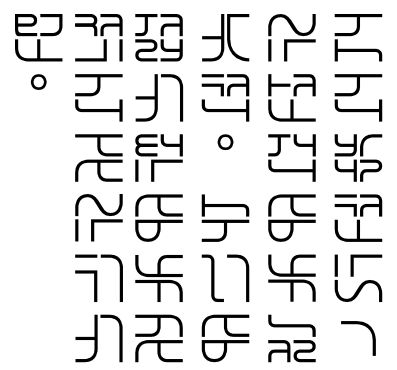![]()
Satzī alphabet
The Satzī alphabet was created by Charles Heisler for his
constructed language, Mor’osi. The alphabet’s name (which can also
be applied to the individual letters) is Mor’osi for “primary characters”,
and the alphabet itself was inspired in part by both Korean Hangul
and the Shavian Alphabet. Both the language and the alphabet have
undergone many changes since they were first conceived, leaving
behind a number of archaic letters and letter forms.
Notable features
- Satzī may either be written in vertical columns, read
top to bottom from right to left, or in horizontal rows, read left
to right from top to bottom. - 16 letters of the Satzī alphabet have weak (mel)
and strong (rau) forms. For vowels weak and strong forms
represent short and long vowels respectively. For consonants they
distinguish voiceless and voiced consonants. The exception is men,
whose weak and strong forms represent /m/ and /n/. The weak form
is simply the unmodified letter. The strong form is indicated for
vowels and the consonants woh and yo by flipping
the letter across its vertical axis and for other consonants by rotating
them 180 degrees. - Letters are arranged in blocks of text, each representing a
syllable. How they are arranged depends on the particular syllable.
Letters assume one of 4 forms based on the syllable and their place
in it: square (bok), wide (sech), tall (vet)
or full (om). Square letters are left unmodified and fill a
quarter of the block, wide letters are rotated 90 degrees counter-clockwise
and stretched to fill either the top or bottom, tall letters are
stretched to fill either the left or right and full letters simply
fill the entire space. These transformations are applied after any
done to create a strong form. In all there are 6 possible arrangements
for a text block. - Shongzī is not considered a letter and is used
to indicate the repetition of the previous syllable. It is s a vertical
slash when writing in vertical columns and a horizontal one when writing
in horizontal rows. - The dipthongs are written using pairs of vowels, with ū
and ī representing the semivowels [ɰ] and [j].
Satzi alphabet

Archaic Satzi

Sample text

Transliteration
Om on hiochsat sū ī us shatmon al ādyhau dē
san. Moyī al mauh dī bos al ād ha kaz on va us sī
dī ret.
Translation
All human beings are born free and equal in dignity and rights. They
are endowed with reason and conscience and should act towards one another
in a spirit of brotherhood.
(Article 1 of the Universal Declaration of Human Rights)
